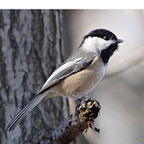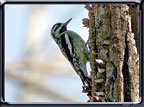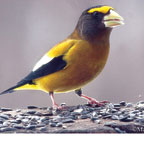For the Birds: Christmas Count Is A Holiday Tradition
By Maureen Halsema

(Left to right) Yellow-bellied sapsucker, Red-breasted nuthatch, Evening Grosbeak, and the Black-capped chickadeing. Photos by Matt Orsie.



The longest-running wildlife census—the Christmas Bird Count—will kick off its 110th year starting Dec. 14, 2009. The annual event is sponsored by the National Audubon Society and other collaborative organizations, and will run until Jan. 5, 2010.
This massive event was started in 1900 by an ornithologist named Frank Chapman, who was one of the early officers in the Audubon Society. Chapman replaced an annual holiday hunting tradition, the Christmas “Side Hunt”—in which teams competed for the biggest lot of birds killed—with a census of live migratory birds.
The first Christmas Bird Count involved 27 counters—ranging from Toronto, Ontario to Pacific Grove, Calif.—who counted 18,500 birds, including 90 different species. Over the past century the number of counters and regions have grown. The 2009 count reported an all time high of over 59,000 observers who counted 65.5 million birds.
Local counts take place in count circles. Each circle has a 15-mile diameter and is led by a local compiler. Groups are arranged so that beginning birders team up with more seasoned birdwatchers, allowing people of all experience levels to join in on the fun.
The Christmas Bird Count is a valuable resource for assessing the long-term health and status of bird populations and for shaping bird conservation efforts. The Christmas Bird Count—combined with the North American Breeding Bird Survey—provides an idea of how bird populations across the United States have changed over the past hundred years.
The Breeding Bird Survey is a collaborative effort between the U.S. Geological Survey’s Patuxent Wildlife Research Center and the Canadian Wildlife Service’s National Wildlife Research Centre. The two organizations cooperatively monitor the status and long-term trends of North American bird populations.
Data from the Christmas Bird Count and the Breeding Bird Survey can help scientists identify environmental factors that may impact humans. For instance, changes in migratory behavior can indicate groundwater contamination.
“Bald eagles are starting to come back to Morgantown because we have cleaned up our waterways and there are more fish now,” said LeJay Graffious, coordinator for the Morgantown Mountaineer Audubon Christmas Bird Count. “You know, 15 years ago we would have never seen a bald eagle—now we get three or four on a count.”
The biggest threat to migratory birds is loss of habitat. Residential developments take away habitats for birds such as the meadowlarks. Industry also impacts bird habitats.
“I don’t know of any counts that were near any of the mountaintop removal sites,” said Graffious, “but habitat-wise it is probably the biggest threat to Appalachian species.”
The Audubon Society has tools that help people to access data collected by the thousands of Christmas Bird Count volunteers. The output tools arrange the data in a visual format, allowing users to make maps of bird distributions, construct graphs of species trends over time, preview the raw count data, and even look up data on their favorite species.
In southern Appalachia, a wide range of species migrates across the diverse landscape. The counters in this region are likely to encounter American black ducks, mallards, hooded mergansers, pied-billed griebs, several species of hawks, American kestrels, Eastern screech owls, and American goldfinches.
To participate in this year’s bird count, contact your local compiler via Audobon.org to find out how you can volunteer. Express your love for birds and enjoy a little friendly competition with all the other bird count circles!
Related Articles
Latest News

Leave a comment
Your email address will not be published. Required fields are marked *




